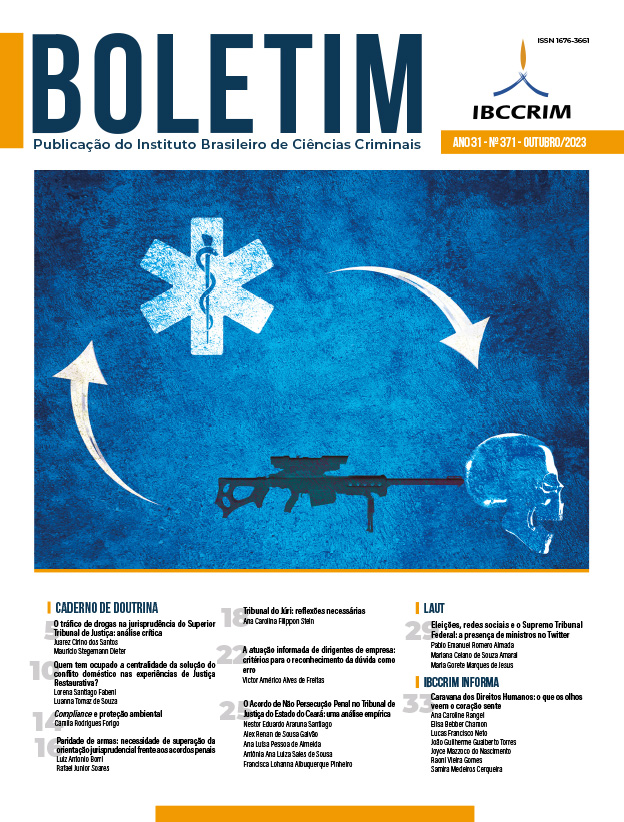Drug trafficking in the legal precedents of the Superior Court of Justice: a critical analysis
DOI:
https://doi.org/10.5281/zenodo.8350295Keywords:
Criminology, Drug policy, Prohibition, Legal precedent, Superior Court Of JusticeAbstract
An analysis of the Superior Court of Justice legal precedents about drug trafficking can contribute to the rationalization of criminal procedures responsible for 28% of Brazil’s prison population. In arrests for drug trafficking sting operations, the interchangeability of the action of selling charged in the indictment, for the typical actions of having in deposit, storing, transporting or bringing drugs with them, besides being an artifice to circumvent Precedent 145/STF, disregards differences in the subjective type of the interchanged actions, because these actions contain the special subjective element of the purpose of personal consumption (art. 28), or commercialization (art. 33) of the Drug Law. Moreover, by rejecting principle of insignificance because drug trafficking is considered a formal crime, to which charges are brought by the mere activity, it creates an incompatibility with the importance given to drug quantity in the differentiation between drug trafficking and personal consumption, which indicates that drug trafficking is not a formal crime, but rather requires an outcome. Furthermore, denying privileged trafficking (art. 33, § 4th) based on investigations or ongoing criminal procedures is contradictory with the legal precedent of the Precedent 444/STJ, which prohibits increase or prevents reduction of prison time in sentencing, with equal practical significance. Lastly, criminology reveals the failure of punitive drug policy: Dan Werb’s research indicates an increase in drug purity and quantity, as well as a price reduction for the drug user in international markets between 1990 and 2010, despite the billions of dollars invested in prohibition policy and the unbearable destruction of young black men’s lives on poor urban areas.
Downloads
References
BRASIL. Lei 11.343, de 23 de agosto de 2006. Institui o Sistema Nacional de Políticas Públicas sobre Drogas - Sisnad; prescreve medidas para prevenção do uso indevido, atenção e reinserção social de usuários e dependentes de drogas; estabelece normas para repressão à produção não autorizada e ao tráfico ilícito de drogas; define crimes e dá outras providências. Brasília, DF: Presidência da República, 2006. Disponível em: https://www.planalto.gov.br/ccivil_03/_ato2004-2006/2006/lei/l11343.htm. Acesso em: 18 set. 2023.
BUENO DE CARVALHO, Amilton; CARVALHO, Salo de. Aplicação da pena e garantismo. 2. ed. Rio de Janeiro: Lumen Juris, 2002.
SANTOS, Juarez Cirino dos. Direito penal: parte geral. São Paulo: Tirant lo Blanch, 10. ed. 2022.
DAL SANTO, Luiz Phelipe Oliveira. A punição no Brasil: crítica do giro punitivo. 2020. Dissertação (Mestrado) – FACULDADE, UNIVERSIDADE, CIDADE, 2020.
JESCHECK, Hans-Heinrich; WEIGEND, Thomas. Lehrbuch Des Strafrechts: Allgemeiner Teil. Berlim: Duncker & Humblot: 1996.
KARAM, Maria Lucia. “Guerra às drogas” e saúde: os danos provocados pela proibição. In: LOPES, Lucília Elias; BATISTA, Vera Malaguti (Orgs.). Atendendo na guerra: dilemas médicos e jurídicos sobre o crack. Rio de Janeiro: Revan, 2014. p. 281.
SCHEERER, Sebastian. Limites sociais e legais da reforma da legislação de drogas. In: O Criminólogo alemão: uma jornada com Sebastian Scheerer. Tradução: Amós Caldeira. Revisão: Ricardo Genelhú. São Paulo: USP, 2018. p. 281.
SUANNES, Adauto Alonso. Os fundamentos éticos do devido processo legal. São Paulo, Revista dos Tribunais, 1999.
WERB, Dan; KERR, Thomas; NOSYK, Bohdan; STRATHDEE, Steffanie; MONTANER, Julio; WOOD, Evan. The temporal relationship between drug supply indicators: an audit of international government surveillance systems. British Medical Journal, v. 3, 003077, 2013. https://doi.org/10.1136/bmjopen-2013-003077.
Downloads
Published
How to Cite
Issue
Section
License
Copyright (c) 2023 Prof. Dr. Juarez Cirino dos Santos, Prof. Dr. Maurício Stegemann Dieter

This work is licensed under a Creative Commons Attribution-NonCommercial 4.0 International License.
Copyright of published articles belongs to the author, but with journal rights over the first publication and respecting the one-year exclusivity period. Authors may only use the same results in other publications by clearly indicating this journal as the medium of the original publication. If there is no such indication, it will be considered a situation of self-plagiarism.
Therefore, the reproduction, total or partial, of the articles published here is subject to the express mention of the origin of its publication in this journal, citing the volume and number of this publication. For legal purposes, the source of the original publication must be consigned, in addition to the DOI link for cross-reference (if any).












